Devonport and District Tramways
History
The Devonport and District Tramways were operated by the Devon and District Tramways Company, a subsidiary of the British Electric Traction Company Ltd (BETCo), a concern which over the course of its history either owned, part-owned or leased over 50 tramway concerns across the British Isles.
The D&DTCo was incorporated in 1898, probably after the BETCo had gained powers — on the 12th August 1898 — to construct a 3ft 6ins-gauge overhead electric tramway within Devonport. Whilst the company held powers for circa 5 miles of tramway, these were supplemented — on the 6th August 1900 — by powers for a further 4 miles, but held by Devonport Corporation rather than the tramway company.
The first electric services commenced on the 26th June 1901 over the tracks built by the company. These were joined in 1903 by the two corporation lines — Albert Rd to Peverell, and Camels Head to Saltash Passage, which were extensions to the existing lines, operation being leased to the company. The extension to Saltash Passage was initially operated in isolation, as the bridge over Weston Mills Creek was too weak to support the trams, a situation that was remedied in October 1903, when a new embankment was opened that detoured around the edge of the inlet.
The system (company and corporation lines) was 9.2 miles long and was quite complex, with no central focus. Lines ran: from a terminus in Morice Square, along St Aubyn Rd, then northwards through Keyham, Camels Head and St Budeaux to Saltash Passage; eastwards from a terminus in Fore St to Paradise Rd, where the line split, one continuing eastwards along Paradise Rd and Stuart Rd to Pennycomequick, and the other heading northeastwards along what is now Devonport Rd, through Stoke, Milehouse and Peverell to the borough boundary opposite Tor Lane. Connecting lines ran: eastwards from the Saltash line, along Albert Road to join the Pennycomequick line at Stoke; northeastwards from the Saltash line, along St Levan Rd to join the Peverell line at Milehouse; and southeastwards from the Albert Rd line, along Exmouth Rd, crossing the Peverell line to join the Pennycomequick line at Paradise Rd.
Although the D&DT tracks met those of the Plymouth, Stonehouse and Devonport Tramways Company at Fore St, and Plymouth Corporation at Peverell and Pennycomequick, the tracks remained unconnected during the tenure of the D&DTCo.
The company appears to have had a poor relationship with Devonport Corporation, and at times with the travelling public. Complaints were made in respect of overcrowding, unpunctual services, infrequent services, ticket pricing and track maintenance. The company had a particular issue with the leased lines, particularly that to Saltash Passage, which was unremunerative, and which the company effectively operated at a loss. Things came to a head in 1909 when the company summarily withdrew services, though they were forced to reinstate them by a court order. The situation was only remedied when the company built a tea room near Saltash Passage, which significantly increased traffic on the line.
At various times, the company made approaches to Plymouth Corporation about connecting the two systems up and running through services, but these were rebuffed by the corporation.
The towns of Plymouth, Devonport and Stonehouse were formally merged on the 1st November 1914 to form the enlarged Plymouth Corporation, the latter thereby taking over ownership of the former Devonport lines. In 1915, Plymouth Corporation reached agreement with the company to purchase its assets within Devonport, which presumably also including buying it out of the former Devonport lease. The corporation took possession of the tramway on the 20th October 1915, though some histories quote a date of the 2nd October.
Uniforms
The photographs below show D&DTCo staff wearing the familiar and largely regulation BETCo uniform. Although jackets varied somewhat between BETCo systems, as well as across the decades, the cap badges, collar designations and buttons invariably followed a standard pattern.
Photographs from the earliest years of the system are scarce, so it is not possible to state with confidence what uniforms were worn at the time of opening. Surviving photographs, although taken at a distance, imply that the jackets were double-breasted with lapels, whilst the hats were of the tensioned-crown (top), peaked variety. By analogy with other BETCo systems, it is probable that the jacket collars carried embroidered system initials on both sides.
By 1903, the double-breasted jackets bore five pairs of buttons (of the standard BETCo 'Magnet & Wheel' pattern - see link), three waist-level pockets (with flap closures), and lapels; the collars bore brass badges, ‘D & D T’ on the bearer's right-hand side, in individual letters, and an employee number on the left-hand side. The tensioned-crown peaked caps bore brass insignia, the standard BETCo ‘Magnet & Wheel’ cap badge, with an employee number beneath.
At some point, probably around 1904/5, the double-breasted lapel jackets were gradually superseded, in the case of conductors by single-breasted jackets, and in the case of motormen, by double-breasted, lancer-style tunics; both styles bore stand-up collars, which carried the same insignia as worn on the earlier jackets.
Tramcar crews were also provided with double-breasted greatcoats bearing five pairs of buttons, high, fold-over collars and epaulettes; the latter carried an employee number.
The company also employed the services of young lads, probably points boys or parcels boys; they were provided with single-breasted jackets with high, fold-over collars, along with kepi-style caps. It is unclear what insignia these bore.
Inspectors wore uniforms that followed standard BETCo practice, namely, single-breasted jackets with hidden buttons (or more likely a hook and eye affair), edged in a finer material than the main body of the jacket, with two slit breast pockets and stand-up collars; the latter carried the bearer's grade — 'Inspector' — in embroidered script lettering. Their tensioned-crown peaked caps bore a hat band with the bearer's grade — 'Inspector' — in embroidered script lettering, above which the standard BETCo 'Magnet & Wheel' badge was mounted.
The D&DTCo passed into the hands of Portsmouth Corporation in October 1915, probably prior to the employment of women (during the Great War).
Further reading
For a history of Plymouth's tramway systems, see: 'The Trams of Plymouth — a 73 Years Story' by Martin Langley and Edwina Small; Ex Libris Press (1990).
Images
Motormen and conductors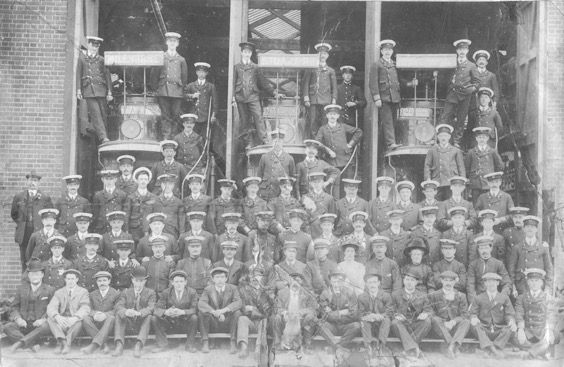
Probably the entire staff of the D&DTCo's Milehouse Rd depot, including fitters and various ladies, the latter presumably the wives of senior officials — photo undated, but probably taken in the mid-Edwardian era. Photo courtesy of the Tramways and Light Railway Society, with thanks to David Voice.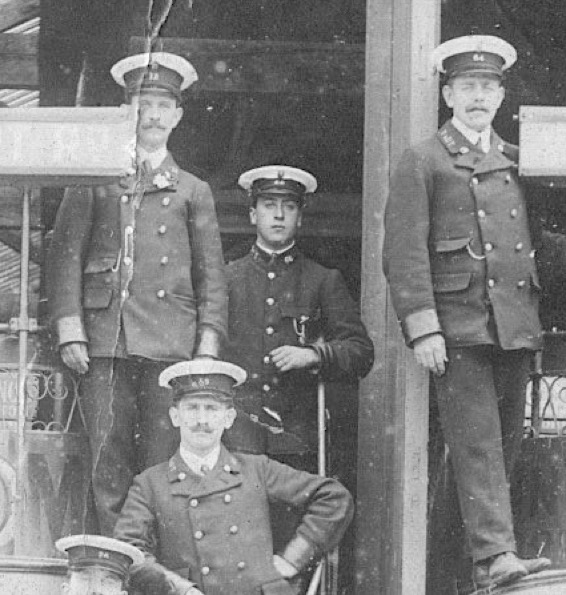
An enlargement of the above photograph showing four individuals, three in double-breasted jackets with lapels and one in a single-breasted jacket with stand-up collars. The collars in both cases carry 'D & D T' initials on the bearer's right-hand side and an employee number on the left-hand side. The caps also bear an employee number, worn beneath the BETCo's standard 'Magnet & Wheel' cap badge.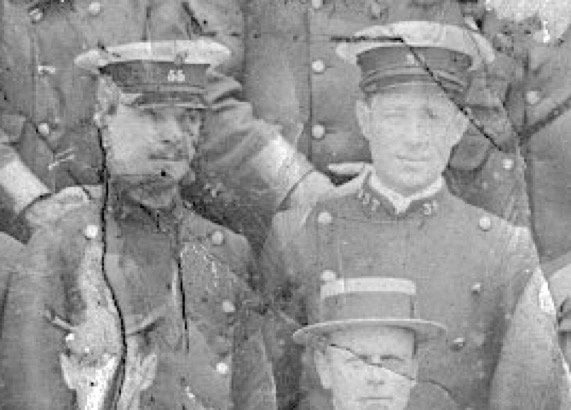
Another enlargement of the above photograph, this time showing two individuals in double-breasted, lancer-style tunics, Employee No 55 on the left, and No 34 on the right. The meaning of the different styles of uniform is unclear; of the 54 tramcar staff depicted, only one individual is wearing a single-breasted jacket, whilst 3 are wearing lancer-style tunics, with the remainder (50) in double-breasted jackets with lapels.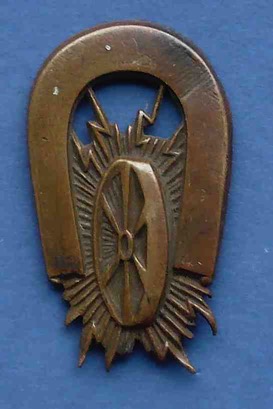
Standard British Electric Traction Company ‘Magnet & Wheel’ badge, as worn by employees of the Devonport and District Tramways Company on their caps — brass. Author's Collection.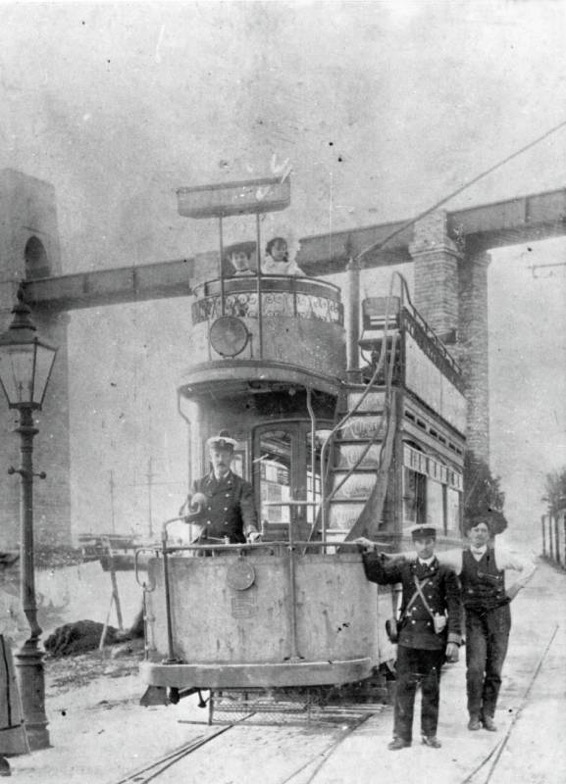
Tramcar No 5 at Saltash Passage — photo undated, but certainly taken after October 1903 when this route was finally connected to the rest of the system. The motorman is thought to be Frank Cook, whilst the man on the right is Mr R Stoneman, the landlord of the Royal Albert Bridge Inn. Photo and background information courtesy of Derek Tait.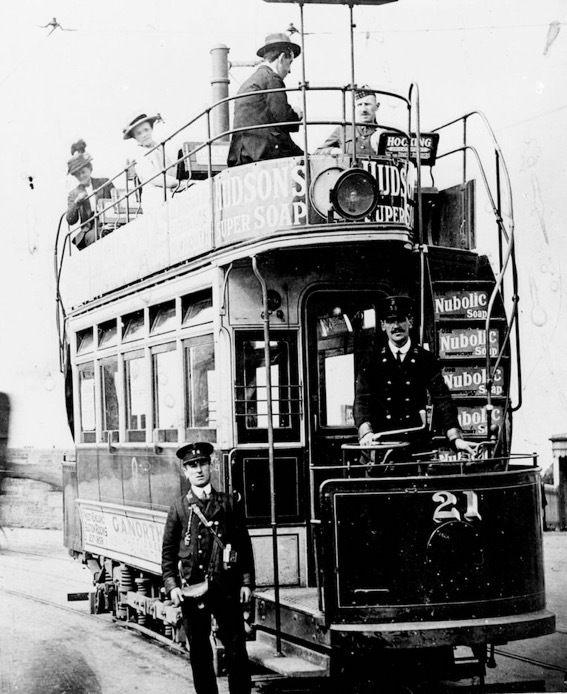
A conductor (Employee No 76) and a motorman (Employee No 55) pose with Tramcar No 21 at St Budeaux — photo undated, but probably mid Edwardian. Photo courtesy of the National Tramway Museum. 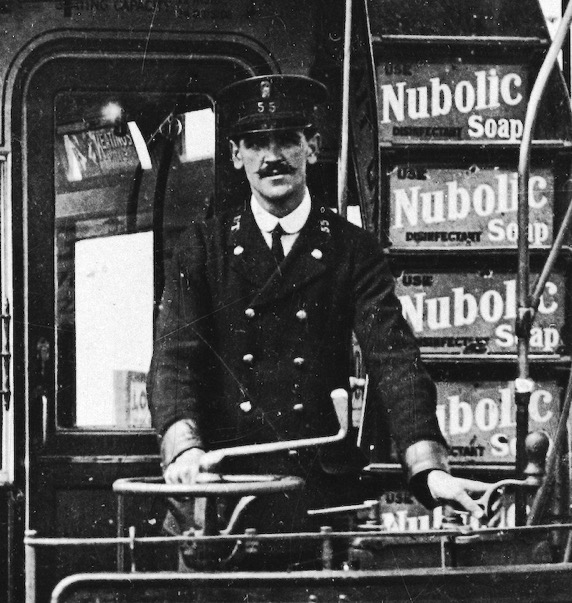
An enlargement of the above photograph showing the motorman — Employee 55; it is unclear whether he is the same Employee No 55 depicted in the enlargement of the depot photo above.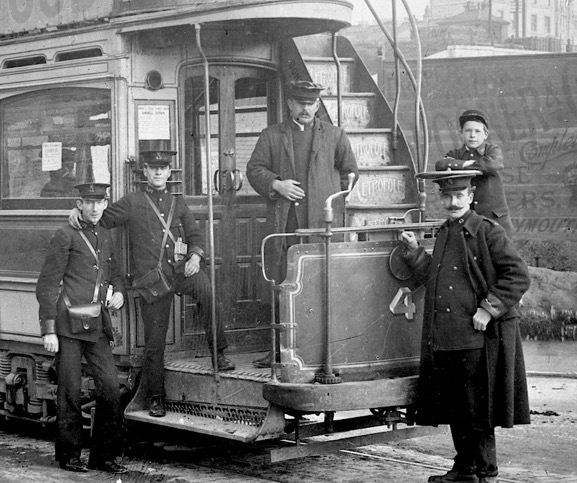
Tramway staff pose with Tramcar No 4 at Pennycomequick — photo undated, but given the battered condition of the tram, probably taken some time between 1910 and the corporation takeover in 1915. Left to right are: two conductors (in single-breasted jackets), a motorman (Employee No 31, wearing a lancer-style tunic and informal topcoat), another motorman (Employee No 43, standing in greatcoat), and a points boy or parcels boy in a single-breasted jacket and a kepi-style cap. Photo courtesy of the National Tramway Museum. 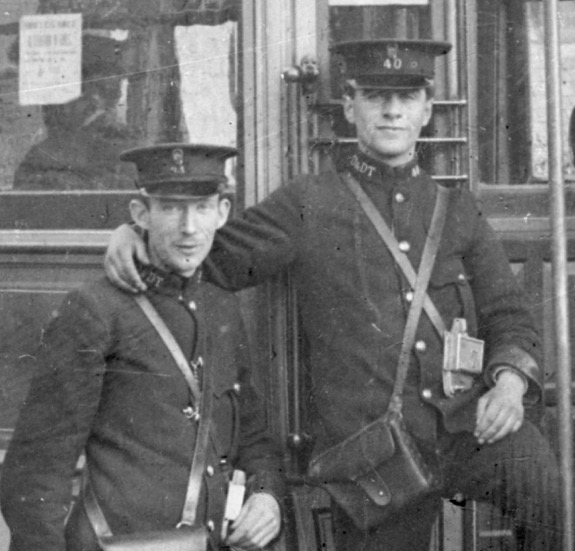
An enlargement of the above photograph showing the two conductors (possibly Employee No 21 on the left and Employee No 40 on the right). The collar initials are individual 'D & D T' initials.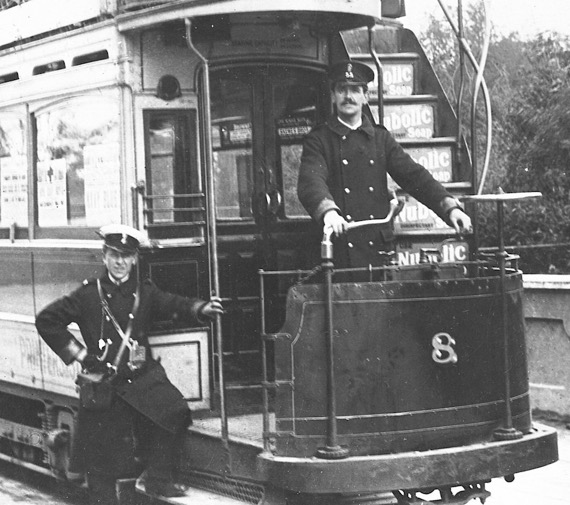
A conductor and a motorman pose with Tramcar No 8 at the terminus in Tor Lane, Peverell — photo possibly taken in 1915, around the time of the municipal takeover. Both men are wearing long greatcoats bearing epaulettes. Photo courtesy of the National Tramway Museum. 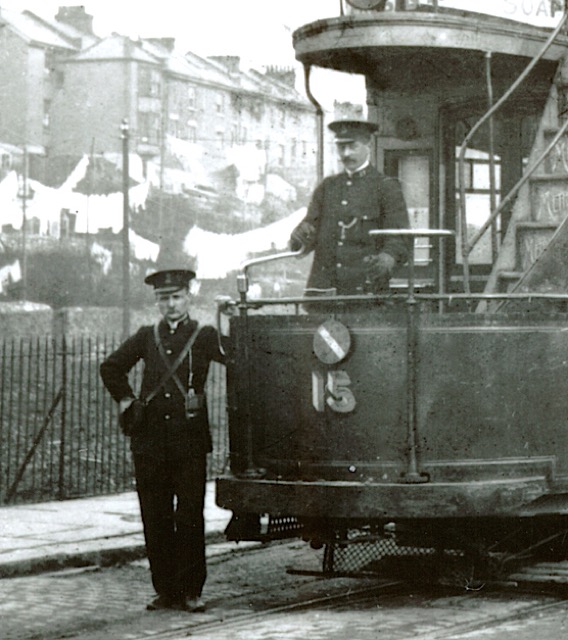
The crew of Tramcar No 15 pose in St Levan's Rd, Devonport with a service for Morice Square — photo undated, but probably taken shortly before the Great War. Photo and background information courtesy of Derek Tait.
Senior staff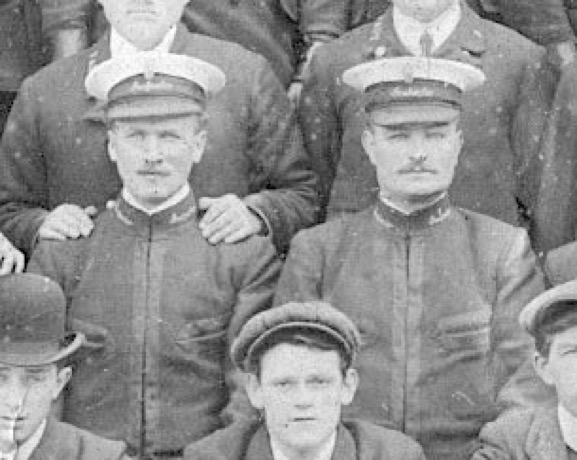
An enlargement of the depot photograph above showing two of the six inspectors. Their caps and jacket collars bear their grade in embroidered script lettering.